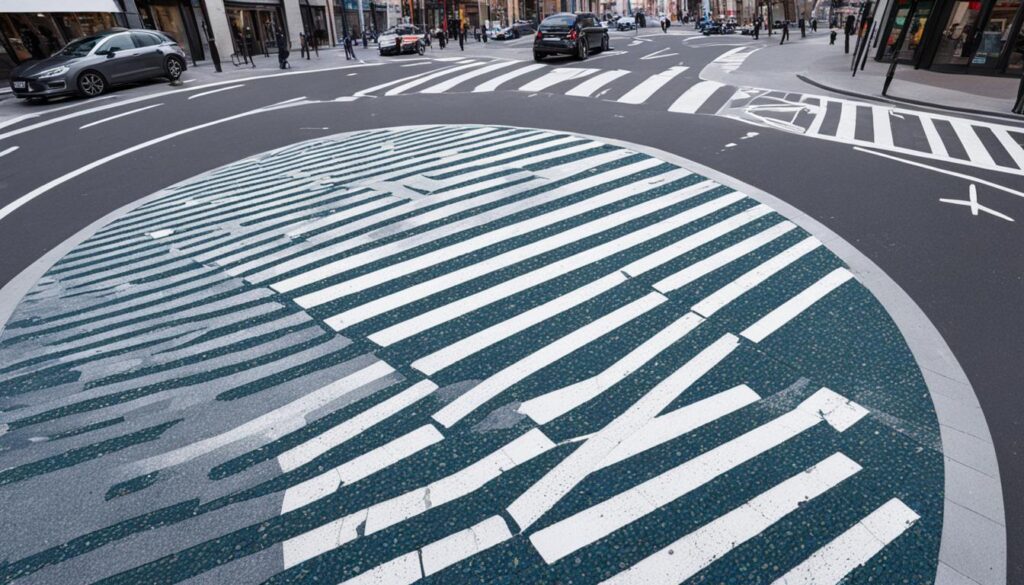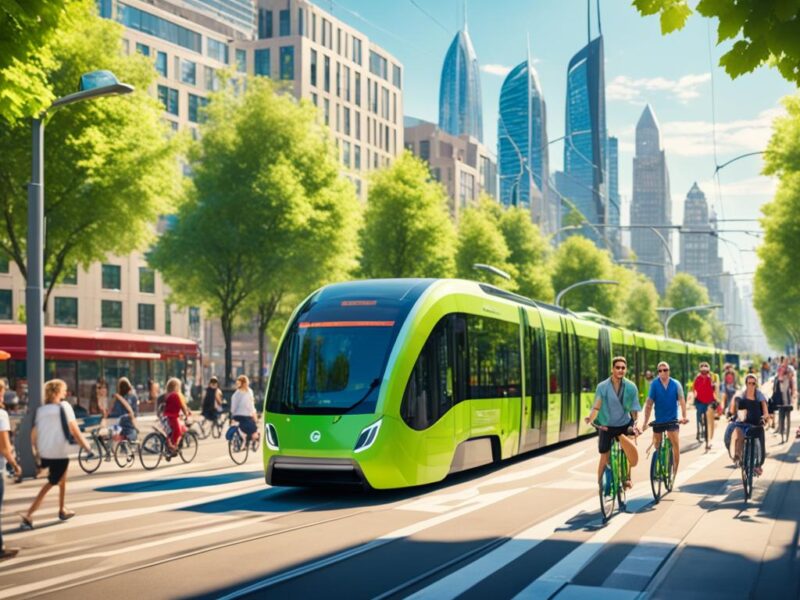
Addressing Accessibility in Public Infrastructure Design
Did you know that approximately 15% of the world’s population lives with some form of disability? This equates to over 1 billion individuals who face unique challenges in their daily lives, including accessing public infrastructure.
Creating equitable and inclusive spaces is essential for ensuring that individuals of all abilities can navigate public infrastructure with ease. In this article, we will explore the importance of accessibility in infrastructure design, the implementation of inclusive design principles, international standards and guidelines for accessibility, and the challenges and solutions associated with creating accessible infrastructure projects.
Key Takeaways:
- Accessibility in public infrastructure design is crucial for individuals with disabilities to access essential services and participate fully in society.
- Inclusive design principles should be integrated into the planning and implementation of infrastructure projects to ensure accessibility for all.
- Adhering to international standards and guidelines, such as WCAG, helps ensure that infrastructure meets necessary accessibility requirements.
- Engaging with individuals with disabilities during the design process can help identify key challenges and inform actions for accessibility.
- Creating accessible infrastructure promotes inclusivity and eliminates barriers to participation for individuals with disabilities.
Understanding the Importance of Accessibility in Infrastructure
Accessibility in infrastructure is crucial for creating a barrier-free environment that enables the access and use of facilities by individuals with diverse physical abilities. By incorporating inclusive design principles, infrastructure can be made accessible to all, ensuring equal opportunities for employment, transportation, healthcare, and other essential services. Compliance with ADA accessibility standards is essential to guarantee that infrastructure meets the necessary requirements for accessibility.
“Accessibility is not only about physical access but also about providing an inclusive environment that empowers individuals with disabilities to fully participate in society.”
When designing accessible infrastructure, it is crucial to consider various factors such as ramps, tactile markers, accessible signage, and adapted toilets. These considerations enable individuals with disabilities to navigate and utilize the infrastructure independently. By implementing inclusive design, we can create an environment where every individual can thrive and contribute to society.
Compliance with ADA accessibility standards ensures that infrastructure projects meet the legal requirements for accessibility. The ADA (Americans with Disabilities Act) is a comprehensive civil rights law that prohibits discrimination based on disability. This legislation sets standards for accessible design and outlines the necessary features to incorporate in infrastructure projects to promote accessibility.
By prioritizing accessibility and adhering to applicable standards, infrastructural developments can eliminate barriers that prevent individuals with disabilities from fully participating in society. These efforts contribute to a more inclusive and equitable society, where everyone has equal access to services, opportunities, and experiences.
Now let’s take a look at a table that highlights the key accessibility features and their impact on infrastructure design:
| Accessibility Feature | Impact on Infrastructure Design |
|---|---|
| Ramps | Allow wheelchair users to navigate changes in elevation, ensuring seamless access to different areas. |
| Tactile Markers | Provide tactile cues for individuals with visual impairments, helping them navigate safely. |
| Accessible Signage | Ensure clear and visible information for individuals with visual impairments or cognitive disabilities. |
| Adapted Toilets | Accommodate the needs of individuals with disabilities, promoting convenience and autonomy. |
Understanding the importance of accessibility in infrastructure is vital for creating a society that values inclusivity and equal access for all individuals, irrespective of their abilities. By embracing inclusive design principles and complying with relevant accessibility standards, we can ensure that infrastructure projects serve the needs of the entire community.
Implementing Inclusive Design in Infrastructure Projects
Inclusive design is a fundamental aspect of creating accessible infrastructure projects. From the planning stage onward, it is crucial to incorporate accessibility features that cater to the needs of all individuals. By prioritizing inclusive design principles, we can ensure that infrastructure is usable and beneficial for people with disabilities.
One of the key considerations in implementing inclusive design in infrastructure projects is the incorporation of accessibility features. By incorporating features such as accessible pathways, elevators, and tactile indicators, we can enhance the overall accessibility of the infrastructure and make it easier for individuals with disabilities to navigate and utilize the space.
However, it’s not enough to simply include these features in the plans. It’s equally important to conduct thorough accessibility testing to identify and address any potential barriers. Accessibility testing helps ensure that the infrastructure meets the needs of individuals with disabilities and provides a seamless experience for all users.
“Accessibility testing is not a one-time event; it should be an ongoing process throughout the lifecycle of the project.”
Additionally, incorporating assistive technology is crucial for further enhancing the accessibility of infrastructure projects. Utilizing tools such as screen readers, alternative input devices, and captioning systems can significantly improve the accessibility and usability of the infrastructure for individuals with different types of disabilities.

The Impact of Assistive Technology
Assistive technology plays a vital role in creating a more inclusive environment. It provides individuals with disabilities the tools they need to overcome barriers and access information, services, and opportunities. By embracing assistive technology, infrastructure projects can open doors for individuals with disabilities and empower them to fully participate in society.
| Assistive Technology | Benefits |
|---|---|
| Screen Readers | Converts text into speech, enabling individuals with visual impairments to access digital content |
| Alternative Input Devices | Allows individuals with limited mobility to interact with digital interfaces using adapted input devices such as switches or voice recognition |
| Captioning Systems | Provides text versions of audio content, making it accessible for individuals with hearing impairments |
In conclusion, implementing inclusive design in infrastructure projects is crucial for promoting accessibility and ensuring that individuals of all abilities can enjoy equal access to public spaces. By incorporating accessibility features, conducting thorough testing, and leveraging assistive technology, we can create infrastructure that caters to the needs of everyone in our society.
International Standards and Guidelines for Accessibility
International standards and guidelines play a crucial role in ensuring accessibility in infrastructure design. These standards provide a comprehensive framework for designers and developers to follow, ensuring that their projects meet the necessary accessibility criteria and contribute to a more inclusive society.
One of the key international frameworks for accessibility is the Web Content Accessibility Guidelines (WCAG). Developed by the World Wide Web Consortium (W3C), WCAG provides detailed guidelines and success criteria for creating accessible web content. Adhering to WCAG compliance is essential in ensuring that digital platforms are accessible to individuals with disabilities.
In addition to WCAG, the ISO approach is another prominent international standard for accessibility. The International Organization for Standardization (ISO) has developed a series of standards to address accessibility across various domains, including information and communications technology, transportation, and the built environment.
By following these international standards and guidelines, designers and developers can implement best practices for accessibility in infrastructure projects. They outline key accessibility requirements and provide guidance on incorporating accessibility features into the design process. Staying updated with the latest standards and guidelines is crucial in ensuring WCAG compliance and creating truly accessible and inclusive environments.
Implementing these accessibility standards not only benefits individuals with disabilities but also contributes to a more equitable society, where everyone has equal access to essential services and opportunities. By prioritizing accessibility, infrastructure projects can eliminate barriers and create a more inclusive and accessible world for all.
Comparison of WCAG and ISO Approach
| WCAG | ISO Approach |
|---|---|
| Specially designed for digital content and web accessibility. | Covers a broader range of domains, including built environment and transportation. |
| Provides detailed guidelines and success criteria for accessibility. | Offers a comprehensive approach to accessibility, including principles, requirements, and recommendations. |
| Primarily focuses on web accessibility. | Addresses accessibility across various domains beyond digital content. |
| Developed by the World Wide Web Consortium (W3C). | Developed by the International Organization for Standardization (ISO). |
By leveraging the insights from these internationally recognized standards and guidelines, designers and developers can ensure that their infrastructure projects are accessible to individuals of all abilities.
Challenges and Solutions for Accessibility in Infrastructure
Ensuring accessibility in infrastructure projects poses several key challenges that need to be addressed to create inclusive and barrier-free environments. One of the primary challenges is catering to the diverse needs of individuals with different disabilities. Each disability requires specific considerations and accommodations to ensure equal access and participation.
Contextualization and durability are additional challenges that must be taken into account when implementing accessibility features. Infrastructure projects should be designed to blend seamlessly within their surroundings, preserving the aesthetics and functionality of the environment. It is essential to create accessible infrastructure that stands the test of time, enduring changing conditions and remaining functional for years to come.
To overcome these challenges, it is crucial to engage with individuals with disabilities throughout the design process. By consulting with disabled individuals and organizations, designers can gain valuable insights into the specific needs and preferences of the community. This collaborative approach helps identify key challenges and informs the necessary actions for creating truly accessible infrastructure.
Inclusive design principles should guide the implementation of accessible infrastructure projects. By prioritizing universal design, which aims to accommodate the widest range of users, infrastructure can be made accessible to individuals with various disabilities. Considerations such as providing ramps, accessible pathways, and adaptive toilets can vastly improve accessibility and promote inclusivity.
“Implementing accessible infrastructure projects that prioritize universal design principles and consider the specific needs of individuals with disabilities is crucial for promoting inclusivity and eliminating barriers to participation.”
To ensure the durability of accessibility features, infrastructure projects should take into account the challenges posed by different environmental conditions. By selecting materials that are resilient to weathering, wear and tear, and other factors, infrastructure can maintain its accessibility features and functionality over time.
Actions for Accessibility in Infrastructure:
- Engage individuals with disabilities and disability organizations during the design process
- Prioritize universal design principles
- Implement ramps, accessible pathways, and adaptive toilets
- Select durable materials that can withstand environmental conditions
By addressing key challenges and taking proactive actions to ensure accessibility, infrastructure projects can contribute to a more inclusive society. Creating accessible infrastructure that is durable, contextually appropriate, and considers the specific needs of individuals with disabilities is crucial to eliminate barriers to participation and promote equal access to essential services and opportunities.
Conclusion
Addressing accessibility in public infrastructure design is crucial for creating inclusive and equitable spaces that can be accessed and utilized by individuals of all abilities. By integrating accessibility principles and adhering to international standards and guidelines, infrastructure projects play a vital role in contributing to a more inclusive society.
Through the implementation of inclusive design and accessible infrastructure, barriers to participation can be eliminated, allowing individuals with disabilities to enjoy equal access to essential services and opportunities. Prioritizing accessibility in infrastructure projects is of utmost importance, requiring the collective efforts of designers, developers, and policymakers.
By considering accessibility as an integral part of the design process and following best practices, infrastructure projects can ensure inclusivity for all individuals. The adoption of universal design principles and the provision of accessible features like ramps, tactile indicators, and adapted facilities enable individuals with disabilities to engage fully in society.
Ultimately, by prioritizing accessibility in public infrastructure design, we can create a society where individuals of all abilities can thrive and have equal access to essential services and opportunities. It is essential to embrace the value of inclusive design and accessible infrastructure to foster a more inclusive and barrier-free environment for everyone.







